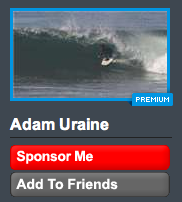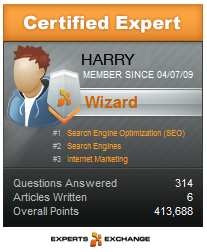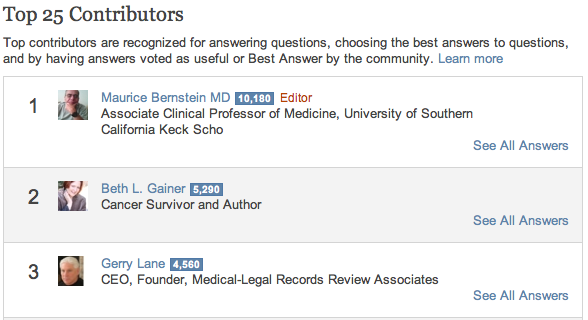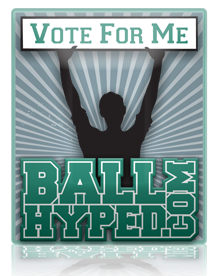
How to Get Your Community to Build Links For You
Building links is widely regarded as one of the most difficult and time consuming aspects of SEO. If you have a community centric site, you should spend some of your time allocated for link building on creating features that will get your users to do your link building for you. Implementing these community link building features can result in a scalable flow of links to your site.
Profiles
If you give users a self-serving reason to link to their profile, they will be much more likely to link to it. Turn the profile into a portfolio; use a member’s profile to show off their achievements and their top contributions to the site. Double up the incentive and enable members to be freelance through the site – have a “hire me” button on their profile. Something like this would work well for sponsorship sites like Hookit, which has done this well (image from a hookit profile below), putting a "Sponsor Me" button bellow the name and profile shot of each athlete.
Sharing Call To Actions
While this is pretty basic, there are many sites that do not ask users to share their content in any visible way. This can be as simple as adding buttons to share the content in a ribbon at the end of content or in a sidebar. Be careful not to go overboard on the buttons though. While your users may be on many different networks, poppularity of these networks tends to follow the Pareto Principle, where 20% of networks receive 80% of your users’ submissions and attention.
Sharing your content doesn’t guarantee links as social links are often nofollowed, but social is thought, by some, to be a factor in the ranking algorithm so encouraging users to share shouldn’t be neglected.
Voting Content Helpful
Do you enable users to vote content up or down? What do you do with it after it's been voted helpful? When a user votes something up, it means they think the content is good content but they may not be thinking of sharing. You can remind them with an async overlay that appears after voting up. This could easily become annoying, and cause people to stop voting content helpful so it might be a good idea to only do this only one out of every seven or ten times. An easier implementation of this is putting the Facebook “like” button on your site as “liking” content automatically publishes it to your wall. The example below was posted to my wall when I liked a review on Cheap MTB, a mountain bike blog.
Promote Controversial Content
Content that gets people riled up also has a tendancy to get a lot of links. Look at Derek Powazek’s rant on how SEO’s are a bunch of Spammers. Everyone reading the SEOmoz Blog would probably agree that Derek’s rant isn’t valid, but he got a lot of links out of it. Open Site Explorer reports 2,374 links from 423 root domains – some of them from really strong sites like Search Engine Land and Newsvine. Mission Accomplished. Regardless of whether he wrote this as link bait, it became link bait. If there are controversial threads on your site, promote them like crazy. Try and stir up that hornet’s nest and see what happens.

One really easy way to keep these threads/posts going is to promote the most active discussions in the sidebar or at the bottom of other threads. There are a lot of "top discussions" plugins that will highlight content so that you don't have to worry about manually promoting controversial content. That said, if you do notice controversial content, it would probably be smart to promote it in other ways such on Twitter.
Awesome Community Badges
If you have a strong community that loves you, create badges for the community and make a big deal out of them when you release them. Sometimes you can get multiple links out out these badges, but you need to be really careful about how you go about this. I would suggest reading the Unofficial Google Widget Bait Guidelines and Widgetbait Gone Wild. SEOmoz did a great job with their badges and has received links from 485 different root domains with the alt text: i <3 seomoz. Feels good to be loved.
<a href="https://moz.rankious.com/_moz"><img src="https://moz.rankious.com/_moz/img/i-heart-seomoz.png" alt="I <3 SEO moz" /></a>
Ego Boosting User Centric Badges
In addition to creating badges highlighting the community, you should create badges that are focused on the users and their achievements. This will play to the ego of your community members so these badges should really hype up how awesome your users are. Give your users the ability to “level up” and then graphically distinguish between levels of users on the badges; this gives users a) pride in their accomplishments and b) motivation to contribute more to the community. Experts-Exchange has done a great job creating badges, shown below, that show off a users's accomplishments. In the badge below, you can see the user's top categories, how many questions they have answered, how many articles they have written, and how many points they have.
Email Users at Critical Points
What the critical points of interaction for your site? When a users registers, contributes content, “levels up”, when the user's content is voted up, and when users’ content is promoted by staff are some of critical action points that many community sites have in common. Identify which points of contact are critical for your site, then email users at these points and ask them to share either the site or what they have just done. For example, if a user’s review is going to be promoted on the front page or on a popular category page, email the user and let them know that they created something great and that their review is going to be promoted. Encourage the user to tell their friends about their review being promoted on the homepage.
When users register, collect their Twitter names. When their content is being promoted, as in the situation above, you should tweet about it. SEOmoz does a good job of this; when a user's content is published on YOUmoz, SEOmoz tweets it and includes the @username.
Embed Photos
Like videos, photos are shared frequently; the catch is that most sites that host their own videos offer you the ability to embed the video. Most sites that offer photo galleries don’t offer this option. Sites like Pink Bike could stand to benefit from this by having code to “embed this image” below the photo with a couple different sizing options. This is applicable to any site, not just sites offering galleries; if you allow users to upload images to a forum or for a review, you should enable and encourage users to embed the image. Rand did a great Whiteboard Friday on Linkbuilding Through Embedded Content. There are so many opportunities to leverage embedded content, most sites could find a way to build links through embedding content. This is an example of how photo galleries should incorporate this:

Create a Leaderboard
Stroke your top contributors’ egos a bit; dedicate a page to your top users and make sure they know about it so that they can promote it on their own blogs. While a lot of sites do this, I think Medpedia Answers does an especially good job. They provide the avatar and name of the contributor, how many point they have, qualifications and accomplishments, and they link to each members profile and another page with their answers. Medpedia, a medical Q&A site has done a good job recognizing their top users, below is part of their leaderboard.
Combining Tactics FTW! Creating a leaderboard can help you get links, but people might not think to link to it on their own, but with a little encouragement...it could become awesome. When users make it onto this list, they should be informed that they made it on to the list of top contributors. Email them. They can again be notified once they have cracked the top 10, top 5, and 1st place. In the notification email, give them the URL and tell them they should share it with their friends. You could also include a special badge for top contributors (with a rank number) that communicates their accomplishment. Leaderbeard, Email, Sharing, Badges. Double Rainbow.
Interview Top Users
The key to interviewing members is to promote it well. If you prominently position the interview on the site, the contributor will be more likely to feel a sense of accomplishment about the interview, as the article will inherently get more attention because of its prominence. Since they feel proud of their interview, the user is likely to blog about the interview (maybe having an active blog could be a screening requirement for choosing interviewees).
Interviewing experts is often a way to get links as these experts will want to mention these interviews either on their blog or on Twitter. Take this concept and apply it to your users with blogs and strong social media accounts.
What is really important is to always publish interviews to the same URL and make sure that this is the URL that you share with the user, for example: domain.com/user-interview/. When you have a new interview to publish, simply move the old interview to a different location (domain.com/user-interview/username-date.html) and keep the links concentrated on the interview page.
Syndicate Your Content
There are a lot of sites that are hungry for content and would be willing to feature some of your content with an attribution link. If there is a popular news site in your industry, you could ask them if they would be interested in featuring a weekly article, review, blog, photo… that they could feature on their site. Make sure you get attribution links out of it though. An example of a good attribution line would be: How to Fight Bears (link) is part of a weekly series by Adrenaline Adventures (link).
To get users to syndicate your content, offer them custom widgets that could be easily placed on their site or blog. The widget could highlight their recent contributions to the community. This widget would act like an RSS feed that would sit in a user’s sidebar. This Whiteboard Friday is a good resource if you are looking to learn more about syndicating content.
Ask Your Community to Help Grow the Site
If you have a strong bond with your community, explain the basics of SEO to them and ask them to help you out. You can ask them to link to your site and share the content through social media. If you are feeling bold, you can even ask them to link to you using your keywords as anchor text. It is really important when you are directly asking your community to help you with SEO is that you emphasize how this will help the community and how it will help the user who links to the site. Etsy does a great job of explaining what SEO is and how their community members can help to optimize their contributions.
Having a page about helping a new site grow isn’t that uncommon. On these pages, sites will often ask users to link to the community and offer the user badges they can put on their site to show their support. BallHyped, a new sports community, has done a great job of asking people to link to them by putting an emphasis on it being beneficial for the user and the community. As a result, they are having success getting users to support their site with their “Vote For Me” badges (shown below).
While not all of the strategies in this blog post will work great for every site, there should be at least a few that will work for most sites. I hope you are able to apply some of these and have your community bear some of your link building burden. How do you get your community to build links for you? Let me know in the comments.
Hi everyone, my name is Geoff Kenyon and I recently joined Distilled as an SEO Consultant. This is my first post on the SEOmoz blog, but you can expect to see me writing here and on the Distilled Blog. If you have questions or want to say hi, hit me up on twitter @geoffkenyon.
The author's views are entirely their own (excluding the unlikely event of hypnosis) and may not always reflect the views of Moz.









Comments
Please keep your comments TAGFEE by following the community etiquette
Comments are closed. Got a burning question? Head to our Q&A section to start a new conversation.